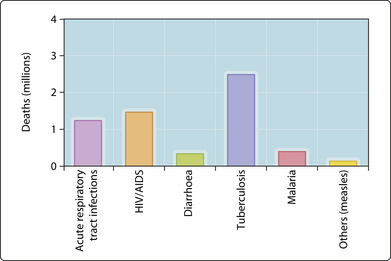36. New and re-emerging infectious diseases
There has been considerable success in combating infection in the developed world since the middle of the last century, through advances in nutrition and hygiene as well as the development of drugs and vaccines. The worldwide eradication of smallpox was a notable success. However, despite many improvements there are still 15 million (> 25%) deaths worldwide attributable to infectious diseases (Fig. 3.36.1). ‘New’ infections are constantly being described (Appendix, Table A.2), and there is always the problem of established infections becoming resistant to current therapies (Table 3.36.1).

Fig. 3.36.1 Number of deaths worldwide caused by infectious diseases.
Source: World Health Organization World Health Report 2000.
Table 3.36.1 EMERGING PROBLEMS OF DRUG RESISTANCE
| Infectious agent | Resistance problem |
|---|---|
| Herpes simplex virus | Aciclovir |
| Human immunodeficiency virus | Zidovudine and others |
| Methicillin-resistant Staphylococcus aureus (MRSA) | β-Lactams (and other antibiotics) |
| Vancomycin-resistant S. aureus (VISA or VRSA) | Methicillin; now also resistant to vancomycin |
| Penicillin-resistant Streptococcus pneumoniae | β-Lactams (and other antibiotics) |
| Neisseria gonorrhoeae | Penicillin, tetracycline, quinolones |
| Glycopeptide-resistant Enterococcus spp. (GRE) | Multiresistance, including to glycopeptides |
| Multidrug-resistant Mycobacterium tuberculosis (MDR-TB) | Isoniazid, pyrazinamide, rifampicin and others |
| Gram-negative organisms with ‘extended spectrum β-lactamases’ (ESBL) | β-Lactams (and other antibiotics) |
| Candida spp. | Fluconazole |
| Plasmodium spp. | Chloroquine |
| Scabies | Lindane |
New diseases
< div class='tao-gold-member'>
Stay updated, free articles. Join our Telegram channel

Full access? Get Clinical Tree








